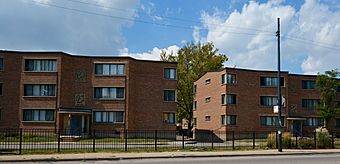Parkway Garden Homes facts for kids
Quick facts for kids |
|
|
Parkway Gardens Apartment
|
|
 |
|
| Location | 6330-6546 S. Dr. Martin Luther King Jr Drive, Chicago, Illinois |
|---|---|
| Area | less than one acre |
| Built | 1950-1955ch |
| Architect | Henry K. Holsman |
| Architectural style | Modern |
| NRHP reference No. | 11000848 |
| Added to NRHP | November 22, 2011 |
Parkway Gardens Apartment Homes is a large apartment complex in Chicago, Illinois. It has 694 units and is located near the Woodlawn and Washington Park areas. These areas are on the South Side of Chicago. The complex was built between 1950 and 1955. Henry K. Holsman, a famous architect, designed its modern buildings. He also planned many other affordable housing projects in Chicago.
Parkway Gardens was special because it was the first apartment complex in Chicago to be cooperatively owned by African-American residents. During the Second Great Migration, many African-Americans moved to Chicago. They faced a shortage of good housing due to segregation. Famous people have lived here, including former First Lady Michelle Obama. Later, rappers like Chief Keef, King Von, and Fredo Santana also lived in Parkway Gardens. Many other artists and music producers have come from this community.
In recent years, the complex has faced challenges. However, it is an important historical site. It is listed on the National Register of Historic Places.
Contents
History of Parkway Gardens
Parkway Gardens Apartment Homes was built from 1950 to 1955. It was one of the last housing projects designed by architect Henry K. Holsman. Holsman started designing affordable homes in Chicago in the 1910s. This was when the city needed more housing after World War I.
He worked on several big housing projects for the Chicago Housing Authority in the 1930s. Later, he began his own projects with money from the Federal Housing Authority. From the 1940s, Holsman focused on designing homes for African-American citizens in Chicago. An example is his Princeton Park community.
Housing for African-American Families
Chicago's African-American population grew a lot from 1920 to 1970. This was due to the Great Migrations. However, unfair housing rules forced African-Americans to live in certain areas. These areas, like the "Black Belt" on the South Side, did not have enough homes.
After building other apartments, Holsman returned to the South Side. He designed Parkway Gardens for the African-American community. The complex was built where the White City Amusement Park once stood. Holsman's company faced financial problems before the complex opened.
A Community Milestone
Parkway Gardens was the first cooperatively owned housing development for African-Americans in the United States. Cooperative ownership meant residents owned shares in the complex. This was a big success for the community.
Many important people attended the groundbreaking ceremony. These included Mary McLeod Bethune, Governor Adlai Stevenson II, and Chicago Mayor Martin H. Kennelly. When it was finished, people who supported affordable housing and civil rights praised the development. They liked its modern heating, appliances, and large apartments. It attracted African-American families with lower incomes. Future First Lady Michelle Obama's family lived there when she was born.
Changes in Ownership
Parkway Gardens changed from cooperative ownership in the 1970s. It then came under HUD management. In the 1980s, it became privately owned. After this change, the property started to decline. Not enough money was spent on keeping it modern and well-maintained.
In 2011, a real estate company bought Parkway Gardens. This company specializes in affordable housing and preserving historic sites. They completed a major renovation of the property in September 2013. This project helped preserve a historic site. It also provided affordable homes for about 2,000 people. The renovation of Parkway Gardens won an award in 2014. It was recognized for being an outstanding real estate project.
Community Challenges
In the early 2010s, Parkway Gardens faced some community challenges. It became known for having more shootings than other blocks in Chicago. However, city police have reported that violence at the complex has steadily declined since 2012. These challenges were mainly due to rivalries between different groups in the area.
Parkway Gardens was added to the National Register of Historic Places on November 22, 2011. This was because of its special architecture and its important role in the African-American community.
Architecture and Design
Henry K. Holsman designed Parkway Gardens Apartment Homes in a Modernist style. He was inspired by European housing projects from the 1920s and 1930s. The complex has low-rise buildings. Many are "walk-up" buildings, meaning they don't have elevators. This gave the complex a more personal feel. At that time, tall skyscraper housing projects were common.
The complex includes thirty-five buildings. Twenty-four of these are walk-up buildings. The other eleven buildings are eight stories tall. The design focused on creating spacious areas with lots of light and fresh air. Entrances faced the inside of the complex, not the street. Instead of fancy decorations, angled bays added variety to the outside walls. This feature was inspired by German "zig-zag houses." The few decorative parts, like balconies and ribbon windows, are typical of Modernist buildings.


